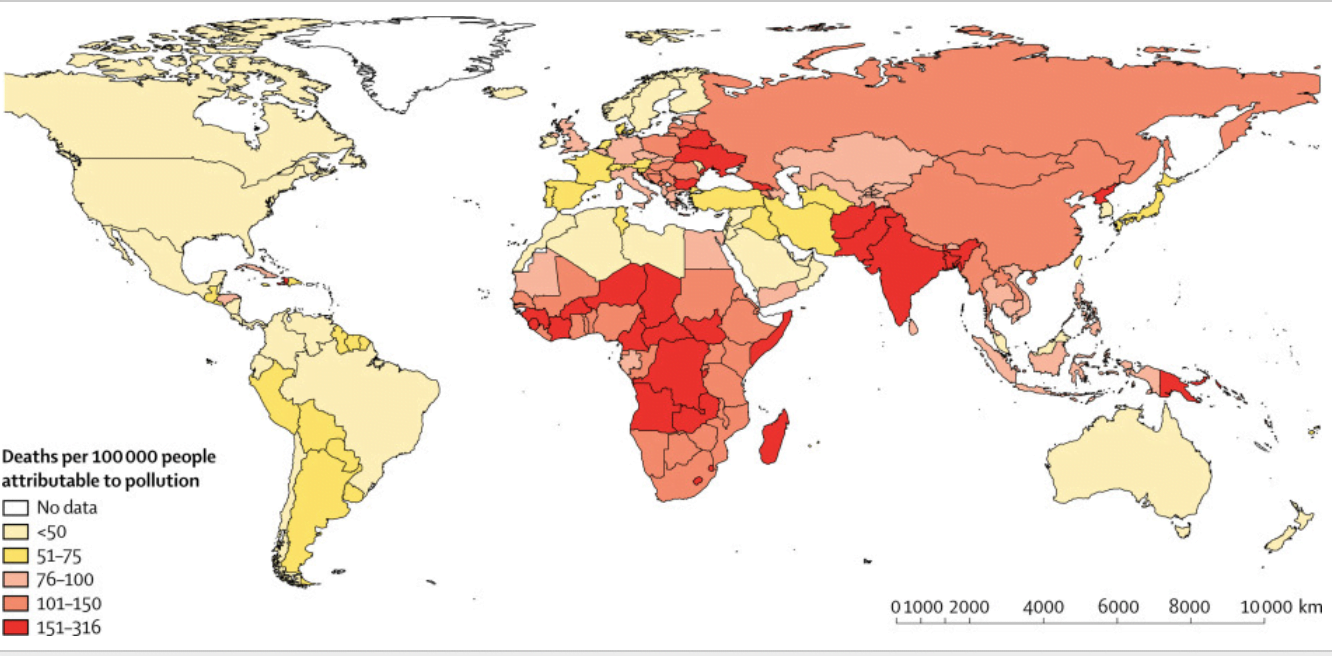Pollution is not just a nuisance. It can kill people–and by the millions. It also keeps countries worst affected by it poorer and unequal.
A new study from The Lancet describes the severe, planetary-scale, harm caused by pollution. Some nine million people around the world die each year from pollution related causes. This is three times more deaths than AIDS, Tuberculosis and malaria combined. The report finds that “in the most severely affected countries, pollution-related disease is responsible for more than one death in four.”
So where do these deaths occur? This map, from the report, shows that nearly every country is affected in one way or another, but some countries fare far worse.

India and China are the world’s most populous feature heavily in the report. Globally, they are ranked first and second for pollution-related deaths. Of the nine million deaths related to pollution that occurred in 2015, 2.5 million of those deaths occurred in India. Another 1.4 million occurred in China.
As the map clearly demonstrates pollution is a global problem, but cities are hotspots for severe pollution, and the rapid urbanization occurring in India and China can partly explain why pollution is so deadly. The Lancet states that “Cities contain 55% of the world’s population; they account for 85% of global economic activity and they concentrate people, energy consumption, construction activity, industry, and traffic on a historically un-precedented scale.”
Pollution may be exceedingly deadly, but the report reminds us that pollution is a “winnable battle.” Indeed,high-income countries have simultaneously improved their air and water and grown their economies. These countries decreased population diseases linked to pollution even as they increase incomes. Developing countries, they state, can learn from this experience and reduce their own pollution while improving livelihoods. They key is effective policy. “Many of the pollution control strategies that have proven cost-effective in high-income and middle-income countries can be exported and adapted by cities and countries at every level of income. These strategies are based in law, policy, regulation, and technology, are science-driven, and focus on the protection of public health.”
Pollution and Sustainable Development
These two countries also represent a path to economic growth that poorer countries are eager to emulate. The Commission reminds us that pollution is not only toxic, but costly. “Pollution is …responsible for productivity losses, health-care costs, and costs resulting from damages to ecosystems. But despite the great magnitude of these costs, they are largely invisible and often are not recognized as caused by pollution”
Taking that toxic road to economic growth also drives inequality, both in its distribution of wealth and in the impact of its pollution.
India and China have been flagged by the IMF for the increases in inequality that have dogged their economic growth. The Lancet points out that the pollution created by this economic growth also worsens inequality. “Pollution disproportionately kills the poor and the vulnerable. Nearly 92% of pollution-related deaths occur in low-income and middle-income countries and, in countries at every income level, disease caused by pollution is most prevalent among minorities and the marginalised. Children are at high risk of pollution-related disease and even extremely low-dose exposures to pollutants during windows of vulnerability in utero and in early infancy can result in disease, disability, and death in childhood and across their lifespan.”
India’s pollution problem – and China’s – is everyone’s problem.
The current approach to economic growth, to “development,” as it is currently known, is dangerous to individual people and to the planet as a whole. Conversely, reducing pollution would benefit literally everyone on Earth. It would accelerate progress toward the SDGs, support social justice, and, finally, support “the health of human civilisations and the natural systems on which they depend.”
Goals don’t get much more important than that.
